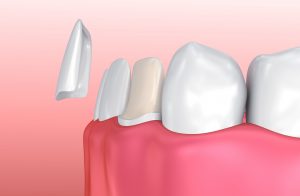 If you’re unhappy with the way your teeth look, veneers are a great solution to give your smile a makeover. The simple, minimally invasive procedure will improve several imperfections at once to give you a picture-perfect smile; however, you’ll need to have some enamel taken off. The hard outer layer of your tooth can’t regenerate, so it’s normal to be concerned about how much enamel needs to be removed for veneers, but there isn’t anything to fear. Here are the facts you need to feel confident in the decision you’re making.
If you’re unhappy with the way your teeth look, veneers are a great solution to give your smile a makeover. The simple, minimally invasive procedure will improve several imperfections at once to give you a picture-perfect smile; however, you’ll need to have some enamel taken off. The hard outer layer of your tooth can’t regenerate, so it’s normal to be concerned about how much enamel needs to be removed for veneers, but there isn’t anything to fear. Here are the facts you need to feel confident in the decision you’re making.
Why Does Enamel Need to Be Removed?
Your teeth are composed of 3 layers: the enamel, dentin, and pulp. Your enamel is the layer you see in the mirror. It’s the hardest substance in your body and protects the softer inner layers. Although your enamel is durable, once it is gone, it’s gone. Your dentist will only recommend removing enamel when absolutely necessary, such as when choosing veneers.
A veneer is a thin shell that’s bonded to the front side of your tooth to improve its color, size, shape, and proportion. To ensure it adheres to your tooth securely, your cosmetic will etch your enamel. Since modern veneers are made of porcelain, they are thinner than ever. As a result, more of your tooth’s structure will stay intact during the bonding process.
How Much Enamel Needs to Be Removed?
Your dentist strives to preserve as much enamel as possible. Every case differs, so they’ll determine how much to remove during your initial consultation. Your dentist will find the perfect balance to ensure the veneer sits flush and bonds well without damaging your tooth. The amount will also depend on the imperfections you’re fixing. A tooth that only has a small chip will require less enamel to be taken off than one that’s being treated for alignment concerns.
No matter the amount removed, your teeth will always need to be covered by veneers or restorations. Thankfully, veneers can last for a decade or longer with the right care, so you won’t need to worry about paying for new ones anytime soon. You can promote the longevity of your smile by maintaining your oral hygiene at home and visiting your dentist at least twice a year for a cleaning and checkup. It’s also best to avoid anything that may damage your veneers, like using your teeth as tools or chewing on inedible objects.
Despite your precautions, a veneer might lose its bond with your tooth over time. Your dentist can quickly replace it to restore your beautiful smile.
About Dr. Carol F. Morgan
Dr. Morgan earned her dental degree at the Medical College of Virginia School of Dentistry and completed additional training at the Las Vegas Institute for Advanced Dental Studies. As a member of the American Academy of Cosmetic Dentistry and many other professional organizations, you can feel confident your smile is in good hands. Contact our office today to see if porcelain veneers are right for you.
